The Pacific Cup: Creating an Enduring Legacy
Published on August 10th, 2015
by Ross Tibbits
Ocean racing between California and Hawaii has a long and storied history. This exciting and beautiful passage has lured intrepid racers for over a century. Although the biennial Pacific Cup is the youngest member of an elite club of races — it celebrates 36 years next summer — it is certainly not the least challenging.
Initially billed as the Kauai Race, the Pacific Cup has remained true to its founding principals to be a fun yet competitive race. Taking a look back, it’s interesting to see what it was like to compete in the first race, well before the age of Spectra, 3DL sails, carbon fiber, satellite telephones and racer trackers.
It all began back in 1979 when Hal Nelson brought up the idea with Ballena Bay Yacht Club’s commodore Vytas Pazemenas. The Single-handed Transpac’s inaugural race from San Francisco to Kauai took place just a year before and Nelson, along with a group of enthusiastic sailors, thought it would be fun to do a similar crossing with crewed boats. They’d selected the Nawiliwili Yacht Club on the southeast corner of Kauai as the destination and a small group of rugged volunteers in Hawaii arranged for the finish.
Months later after many had questioned the viability of such a race (there were already a number of offshore races taking place), racers started signing up. Eventually over 70 skippers had expressed interest in racing to Kauai. But what put the race on the map was the entry of Bill Lee’s famed 67-footer, Merlin, skippered by Norton Smith. On June 15, 1980, 40 boats crossed the starting line proving that Nelson and his visionaries had created something with the potential to endure.
Fast-forward seven years and the race had outgrown both the Ballena Bay Yacht Club and the facilities at the Nawiliwili Yacht Club. George Barrett then spearheaded the formal creation of the Pacific Cup Yacht Club in 1987. A search was done for a new finish line in Hawaii and soon a strong working relationship was developed with the Kaneohe Yacht Club on Oahu. To this day, the Kaneohe Yacht Club remains a steadfast partner of the Pacific Cup Yacht Club and provides one of the most beautiful finish lines the world over.
It’s particularly interesting to hear about the first Pacific Cup from some of those who raced it in 1980. Their experiences highlight the Pacific Cup’s humble beginnings and also make clear that even today participants face many of the same challenges crossing the Pacific Ocean as they did years ago.
John Tysell entered his Cal 3-30 Soufriere in the inaugural race, placing a respectable 2nd in Division V. “We were racing in the ocean and one of my crew asked if I’d heard about the race to Hawaii,” Tysell recalls. “We’d been doing a lot of ocean racing and it sounded like fun.” Tysell and crew were invited to at least three pre-race socials as well as weather and safety briefings. Beyond that, race organizers had developed a detailed and complex support infrastructure for the race, which paid off then, and in future years.
Soufriere had a crew of five that included four guys and Tysell’s girlfriend (who later became his wife). “We did a two-on two-off watch, which worked out really well.” But before their watches began they had to cross the starting line, just offshore of Baker Beach — which proved troublesome. “I was over early at the start and I didn’t find out until we were at Mile Rock — you don’t want to do that in a 2,000-mile race. We were first to reach Mile Rock then and we had to turn around and re-start. Later, we were last to Mile Rock.”
Dean and Pamela Treadway, Transpac veterans and longtime owners of the well-known Farr one-ton Sweet Okole raced that first year as well and won their division. “We did the race again in 2006, 2008, 2010 and 2014,” recall the Treadways. “In 2010 we won our division and also won the Best Performance Trophy. Sailmaker (and fellow Farr one-ton owner) David Hodges was on the boat that year. In 2014 we were well in the lead and set to win without a doubt, but our rudder broke 140 miles from the finish and we had a DNF.”
By many accounts, the first Pacific Cup race was one of the most challenging on record. The weather back then was dramatic and for some, quite dangerous.
“In 1980 it blew 30-35 knots the first two or three days,” says Pam Treadway. “Several boats retired very early on. One boat (William Hall’s 1914 vintage 12-meter, Corsair) ended up on the beach down near Santa Cruz. We were reefed and the waves were crashing clear over the boat. That race seemed longer and the finish was at Nawiliwili Harbor, which had no facilities to handle all of the boats. We were in early yet no berths or docks were available. We had to tie off to a bulkhead and anchor off the back.”
The Soufriere crew faced similar harsh conditions. “We had foul weather gear on for the first two or three days,” Tysell recalls. “One of my crewmembers wore a wetsuit constantly during that time. I had to tell him to take it off because we were sharing a bunk and he was getting pretty ripe.”
The rough weather forced 11 boats to retire early for a variety of reasons, not the least of which were failed rudders. “Rudder posts would leak, another rudder post was bent almost 90 degrees, other rudders just fell off,” says Tysell. “One competitors’ keel separated and that boat was lost at sea. Another boat’s crew ran out of food entirely. There was also a broken boom. But, I would say steering was the biggest problem. If our rudder had failed our emergency system would not have worked. You need to have something that is really solid.”
Equipment failure wasn’t the only serious challenge encountered. “About halfway across,” Tysell recalls, “a Santana 35 called Friendship had a medical emergency.” Apparently the skipper was throwing all kinds of equipment overboard and the crew couldn’t understand why — they thought he might be going through DTs, so they tied him up.
“As a physician, I was talking to the medical officer on board a nearby New Zealand navy ship,” Tysell explained. “We determined that the skipper had gone off his medications — a very serious development that reiterates how important it is to know your crews’ medical conditions and ensure that they continue their medications. The New Zealanders eventually took the skipper on board, medicated him and delivered him to Hawaii.”
At the end of the drama, the Soufriere crew was looking forward to having a little happy hour, which they did on occasion during their crossing. The problem was, they’d run out of ice. Fortunately, the New Zealand Navy, “dropped us a bag of ice and at the bottom of the bag was a bottle of New Zealand Riesling.” Tysell remembers being somewhat concerned that this might be considered some sort of ‘outside assistance’.
The only other real drama the Soufriere crew encountered was when their single sideband (SSB) radio gave up the ghost about a week into the race and they lost all communication and their ability to generate mapping data.
“There was no such thing as a weather map,” said Tysell. “The navigator had to draw out weather maps from information gleaned from the SSB. But after the second half of the race we didn’t have any radio thus no detailed maps.” Once they got into the trade winds they went south and it seemed to pay off for them.
“As we approached the island we heard the Coast Guard on the VHF radio and were able to communicate with them and they informed the race committee where we were. We were fortunate to have a good navigator who was capable with the sextant.”
One of the finest moments of the Pacific Cup, of course, is the finish. This is a special moment for each and every ocean racer, and every one has his or her particular memory associated with their finish. A close friend greeted Tysell on the Nawiliwili Yacht Club’s lawn. He offered Tysell a fresh piece of steak — which he was holding in his hand — and hot showers for the crew. That’s a winning combination.
For the Treadway’s and Sweet Okole it is the finish at Kaneohe that’s particularly special. “It is always fabulous coming into Kaneohe. It feels like Sweet Okole is coming home. That is were she was when I bought her. And of course, after every race the entire Lim family that built the boat greets us. In this year’s Transpac Race we had Wan Su Lim, daughter of Foo Lim, the boat builder, crewing with us.”
Merlin had an incredible finish. Sue Rowley, writing in the August 1980 issue of Latitude 38, told the story. “The chartered fishing boats full of welcomers couldn’t keep up with Merlin as she screamed across the finish line at 15 knots. Her finish, 10 days, 4 hours, 5 minutes, and 52 seconds was not a mainland to Hawaii record, but she was almost 4 days and 700 miles ahead of the second boat in, the Santa Cruz 50, Secret Love from Marina del Rey.”
After that finish Merlin’s crew “donated their magnificent sculptured crystal trophy as a perpetual. The sentiment expressed again and again by the fleet: Ballena Bay Yacht Club did a hell of a job.”
Perhaps it is the idea of finishing a race in one of the most beautiful places on earth that keeps sailors racing to Hawaii — and the competitive yet fun spirit that draws them to the Pacific Cup. But there’s a good chance it’s the thrill of surfing down waves in 20-30 knots of breeze and seeing the islands in the distance.
Regardless, the pure beauty of Hawaii remains steadfast, just as it was in 1980, luring eager sailors from near and far, and knowing there’s a cold Mai Tai waiting for them at the always welcoming Kaneohe Yacht Club.
Staggered starts for the 2016 edition are scheduled between July 11 and 16. Additional race details here: https://pacificcup.org

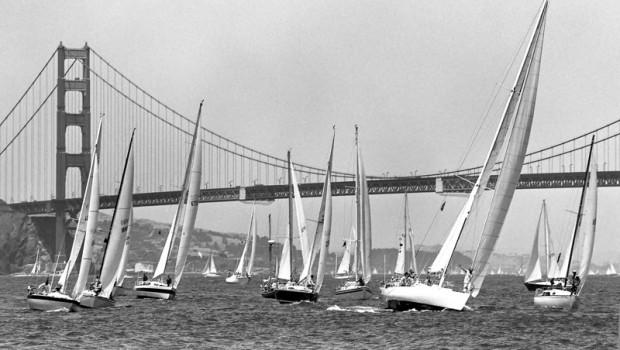


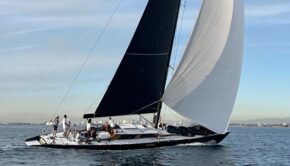
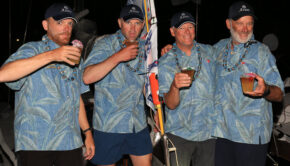
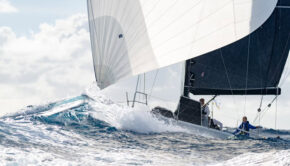
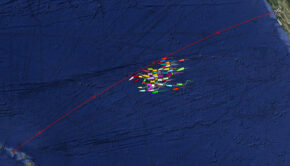
 We’ll keep your information safe.
We’ll keep your information safe.